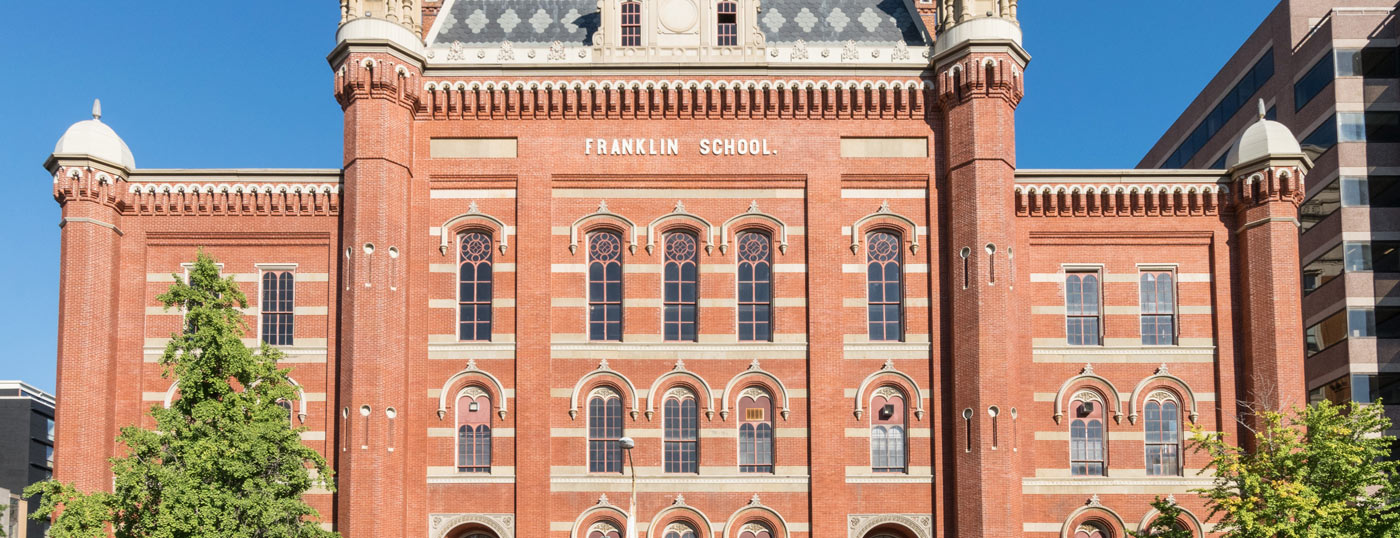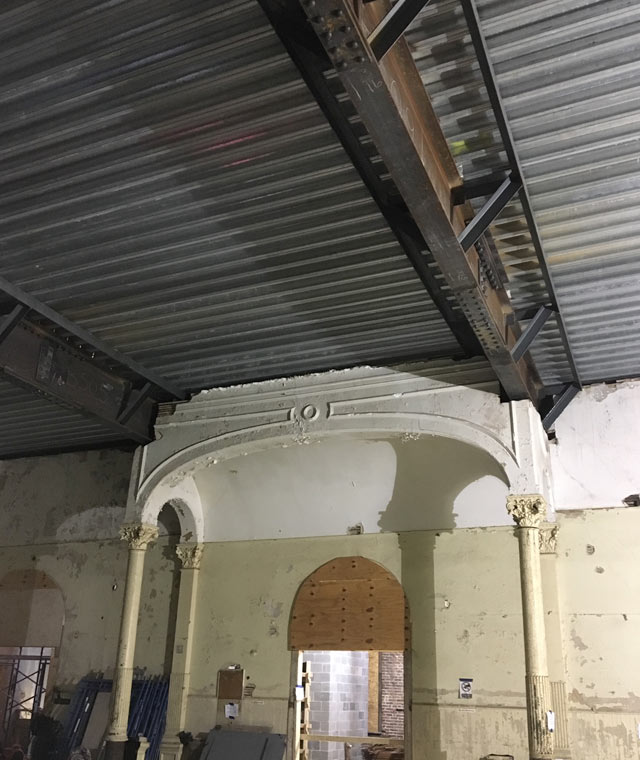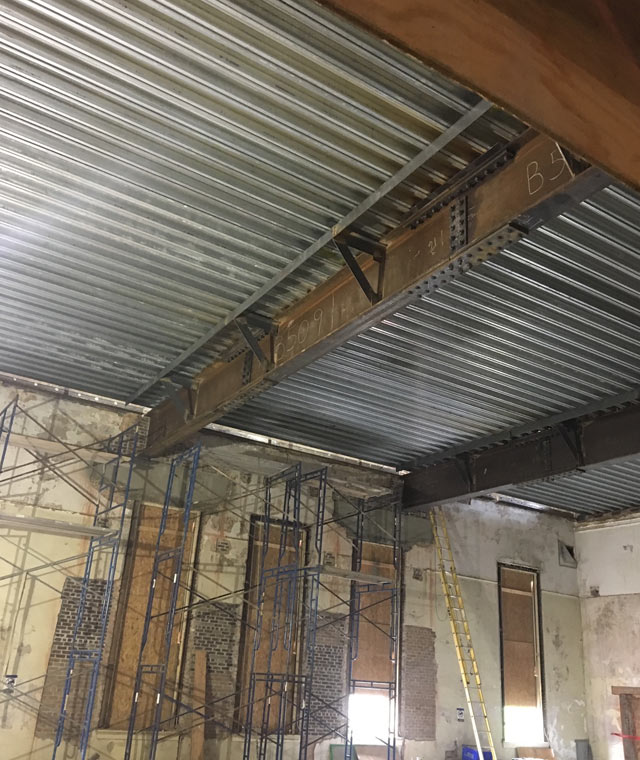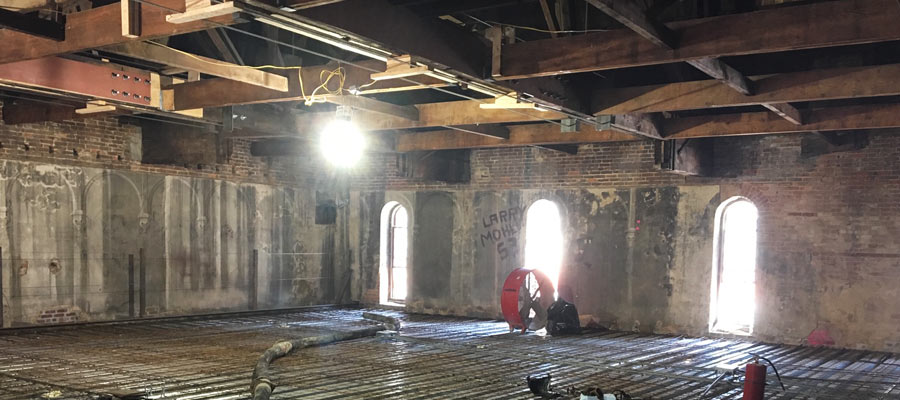
Photo credit: Difference engine / CC BY-SA
On June 3, 1880, Alexander Graham Bell and his assistant Charles Sumner Tainter completed the world’s first wireless voice telephone message from atop the historic Franklin School in Washington, D.C. Using a device called a photophone, Tainter’s words were transmitted on a beam of light to Bell, who was in the pair’s lab about 700 feet away.
Nearly 140 years later, plans call for the Franklin School to open its doors as the Planet Word museum with a mission to inspire “a love of language in all its forms.”
Built in 1869, the 51,000-square-foot Franklin School was added to the National Register of Historic Places in 1966. Both its exterior and interior are protected, complicating efforts to transform the school into a modern museum with technologically advanced exhibits.
The design team at architecture firm Beyer Blinder and Belle was tasked with accentuating the grand open spaces within the innovative structural steel framework. Architects and engineers needed to accommodate the museum’s modern technology in the ornate historical space. The goal was to breathe new life into the Modern Renaissance structure while preserving its protected elements.
“Given the Franklin School’s historic role as a place of learning and exploration, it is fitting that Planet Word will continue using the space in such a unique way to promote creativity and knowledge,” Mayor Muriel Bowser said in announcing the start of renovation in June 2018. “This one-of-a-kind museum will fit right into the culture and fabric of the District and we are proud to be part of this exciting project.”
Because of its protected interior, unshored construction controlled the design, which required the thinnest floor plate with as few interstitial support beams as possible. Standard 3-inch composite deck and the required support beams plus the additional concrete would result in an unflattering floor depth.
New Millennium Building Systems helped realize this vision for Planet Word, supplying a thin-slab composite floor system that created expansive open spans without the need for support beams while supporting high live loads in the form of museum visitors. The shallow deep-ribbed composite floor system’s ability to maximize floor-to-ceiling height makes it ideal for the renovation.
“The large spaces and high ceilings lend themselves to galleries, but we’re not chopping anything up; we’re leaving the spaces as open as possible,” says Ann Friedman, Planet Word Founder and CEO.


The 4.5-inch deep-ribbed composite floor system integrates with wide-flange steel beams, creating spans of 22 feet.
The design team specified a 4.5-inch deep-ribbed long-span composite floor system topped with lightweight concrete to achieve spans of 22 feet and support high live loads (100 psf.) in the form of heavy foot traffic. Existing wide-flange steel beams support the floor system.
The deep-ribbed composite system will get a workout, separating five floors of the building originally designed by Smithsonian architect Adolf Cluss.
Marty Williams, design development manager at New Millennium, says the floor system enables both expansion and preservation.
“Deep-Dek® Composite helps resolve the many challenging design-build concerns of repurposed spaces,” Williams says. “The skill was making it appear effortless to maintain the integrity of the original 1869 structure.”
Architect Gretchen Pfaehler of Beyer Blinder Belle echoes those sentiments.
“One of the challenges with Cluss is that he was very lean and efficient in his construction,” Pfaehler says. “So, we have to be really creative and come up with new solutions, without making it a distraction.”

The existing roof was reinforced with a network of wood supports to create the open space above the museum’s event space, maintaining the existing mansard’s steep pitch. Deep-ribbed composite deck works to establish the expansive floor
A new aspect of the $35 million renovation was the concept of separating the Great Hall into two distinct floors. This created a new programmable event space under the soaring mansard roof. A platform of Deep-Dek® Composite elegantly mediates between the floors, keeping the Great Hall open and column-free, says Alex Therien, market development manager at New Millennium. He says the system’s thin profile and adaptability to any structural frame makes it inherently flexible, which is ideal for adaptive re-use or historic preservation.

The renovation will create nearly 15,000 square feet of exhibit space; an 1,800-square-foot, state-of-the-art auditorium; a 2,500-square-foot restaurant; and 1,500 square feet in classroom space. The project also expands upon the usable space by utilizing below-grade space behind the school.
Despite its historical significance, the Franklin School building had stood vacant since 2008 at the corner of 13th and K Streets in Franklin Square. In previous iterations it was the city’s first co-ed high school, a homeless shelter and an adult education center. The Planet Word website touts the development as a “community anchor and cultural magnet in Washington, D.C., one that makes a difference at the neighborhood level and captivates national and international tourists when they visit our nation’s capital.”
The museum is projected to generate 60 new full-time jobs and welcome nearly 150,000 visitors annually.
“We’re excited to bring Planet Word to the Franklin Square neighborhood, and to be a part of the rebirth of this corner of the city,” Friedman says. “We’re delighted to have been chosen to renovate the Franklin School as a home for Planet Word. This glorious, historic building will now get a new lease on life for another 150 years.”
Therien says the Franklin School project is part of a nationwide trend in urban areas to save historical structures.
“Across the country there are buildings with unique regional characteristics that tell the stories of our cities,” he says. “Breathing new life into them allows that visual history to endure for years to come.”
Building a better steel experience